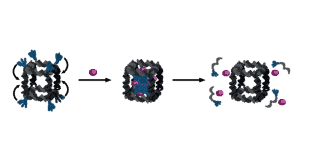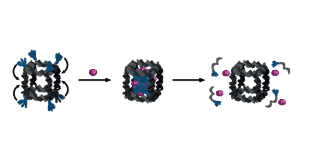
Many different types of nanoparticles have been proposed as improved drug delivery vehicles for nanomedical use, ranging from nanoscale lipid vesicles to atomically precise nucleic acid nanostructures. Together they provide various approaches to solving the many challenges involved in efficiently transporting a drug to the right target. Researchers at McGill University have now modified DNA strands with lipid-like molecules to better hold a cargo of drug molecules. A hat tip to Newswise for reprinting this McGill University news release “DNA ‘cages’ may aid drug delivery“:
Nanoscale “cages” made from strands of DNA can encapsulate small-molecule drugs and release them in response to a specific stimulus, McGill University researchers report in a new study.
The research, published online Sept. 1 in Nature Chemistry [abstract], marks a step toward the use of biological nanostructures to deliver drugs to diseased cells in patients. The findings could also open up new possibilities for designing DNA-based nanomaterials.
“This research is important for drug delivery, but also for fundamental structural biology and nanotechnology,” says McGill Chemistry professor Hanadi Sleiman, who led the research team. …
In their experiments, the McGill researchers first created DNA cubes using short DNA strands, and modified them with lipid-like molecules. The lipids can act like sticky patches that come together and engage in a “handshake” inside the DNA cube, creating a core that can hold cargo such as drug molecules.
The McGill researchers also found that when the sticky patches were placed on one of the outside faces of the DNA cubes, two cubes could attach together. This new mode of assembly has similarities to the way that proteins fold into their functional structures, Sleiman notes. “It opens up a range of new possibilities for designing DNA-based nanomaterials.” …
DNA nanostructures have several potential advantages over the synthetic materials often used to deliver drugs within the body, says Thomas Edwardson, a McGill doctoral student and co-author of the new paper. “DNA structures can be built with great precision, they are biodegradable and their size, shape and properties can be easily tuned”.
The DNA cages can be made to release drugs in the presence of a specific nucleic acid sequence. “Many diseased cells, such as cancer cells, overexpress certain genes,” Edwardson adds. “In a future application, one can imagine a DNA cube that carries drug cargo to the diseased cell environment, which will trigger the release of the drug.” The Sleiman group is now conducting cell and animal studies to assess the viability of this method on chronic lymphocytic leukemia (CLL) and prostate cancer, in collaboration with researchers at the Lady Davis Institute for Medical Research at Montreal’s Jewish General Hospital. …
A look at the Sleiman Group’s recent publications reveals other examples of combining DNA with other molecules to build more useful DNA nanostructures. For example, one difficulty encountered with nanoparticles for drug delivery is that various enzymes in the blood stream will degrade the particle before it can deliver its cargo. A recent paper in Chem. Commun. “DNA nanostructure serum stability: greater than the sum of its parts” [PDF from Sleiman Group] demonstrated that simple chemical modification to oligonucleotide ends using hexaethylene glycol and hexanediol produces significantly increased nuclease resistance under serum conditions, and building DNA cages from these strands gave even greater lifetimes in serum. The authors note in their conclusions that the utility of this approach could extend beyond better drug delivery vehicles, “Such DNA scaffolds offer the potential combination of improved serum stability, simplicity of functionalization for therapeutic functionality, and in the case of ligated prisms, the ability to be used as versatile components of molecular machines.”
A recent J. Am. Chem. Soc. paper reported that inserting small aromatic molecules (intercalators) between DNA base pairs aided error-free self-assembly into DNA nanostructures “Intercalators as Molecular Chaperones in DNA Self-Assembly” [PDF from Sleiman Group]. Adding more chemical functions and interactions to the toolkit for structural DNA nanotechnology may facilitate both near term advances in nanomedicine and progress toward molecular machine systems for atomically precise manufacturing.
—James Lewis, PhD
